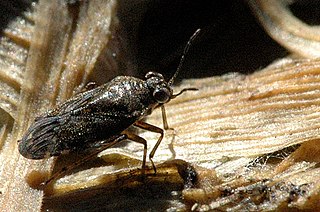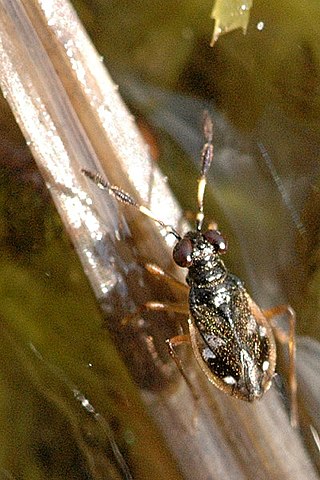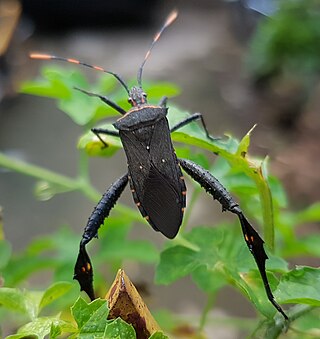
The Reduviidae is a large cosmopolitan family of the suborder Heteroptera of the order Hemiptera. Among the Hemiptera and together with the Nabidae almost all species are terrestrial ambush predators; most other predatory Hemiptera are aquatic. The main examples of non-predatory Reduviidae are some blood-sucking ectoparasites in the subfamily Triatominae, with a few species from South America noted for their ability to transmit Chagas disease. Though spectacular exceptions are known, most members of the family are fairly easily recognizable: they have a relatively narrow neck, sturdy build, and formidable curved proboscis. Large specimens should be handled with caution, if at all, because they sometimes defend themselves with a very painful stab from the proboscis.

Saldidae, also known as shore bugs, are a family of insects in the order Hemiptera. They are oval-shaped and measure 2–8 mm (0.08–0.31 in) when mature. Typically they are found near shorelines or the marginal growths near freshwater bodies, estuaries, and sea coasts. They can flee by leaping or taking flight. There are about 350 recognized species with the majority from the Nearctic and Palearctic. Many species are found in the intertidal zone and both adults and nymphs of some species like Saldula pallipes can tolerate submergence at high-tide. Saldidae are predators and scavengers. They pass the winter through egg or adult diapause.
Coregonus trybomi is a freshwater whitefish in the family Salmonidae. It is a spring-spawning type of cisco, which probably has evolved from sympatric vendace independently in a number of Swedish lakes. Only one of those populations survives, and it is therefore considered Critically Endangered by the IUCN Red List. The status of Coregonus trybomi as a distinct species is however questionable. By Swedish authorities it is treated as a morphotype or ecotype, not an independent species. It was listed as "Data Deficient" in 2010 but excluded from the national red list in 2015.

Hoplandrothrips(commonly misspelled as Hoplandothrips) is a genus of thrips in the Phlaeothripidae family. Some species are recorded as pests on coffee growing in East Africa, causing a distinctive rolling of the leaf. The genus was first described in 1912 by J. Douglas Hood.

Saldoidini is a tribe of shore bugs in the family Saldidae. There are more than 20 genera and 250 described species in Saldoidini.
Acanthocerus is a genus of leaf-footed bugs in the family Coreidae. There are at least three described species in Acanthocerus.

Myodocha is a genus of long-necked seed bugs in the family Rhyparochromidae. There are about 10 described species in Myodocha.

Anasa armigera, the horned squash bug, is a species of leaf-footed bug in the family Coreidae. It is found in North America.

Psallus is a genus of plant bugs in the family Miridae. There are more than 170 described species in Psallus.
Mixogaster breviventris is a species of syrphid fly in the family Syrphidae.
Chrysotoxum chinook is a species of syrphid fly in the family Syrphidae.
Aradus funestus is a species of flat bug in the family Aradidae. It is found in North America.
Pilophorus tibialis is a species of plant bug in the family Miridae. It is found in Central America and North America.

Chelinidea vittiger, known generally as cactus coreid, is a species of leaf-footed bug in the family Coreidae. Other common names include the squash bug and cactus bug. It is found in Australia, Central America, and North America.
Aradus depictus is a species of flat bug in the family Aradidae. It is found in North America.

Cimolus is a genus of leaf-footed bugs in the family Coreidae. There are at least four described species in Cimolus.

Largus succinctus, known generally as Largus bug, is a species of bordered plant bug in the family Largidae. Other common names include the bordered plant bug and red bug. It is found in North America.
Plagiognathus brunneus is a species of plant bug in the family Miridae. It is found in North America.
Plagiognathus albatus is a species of plant bug in the family Miridae. It is found in North America.

Leptoglossus gonagra, known as the passionvine bug, citron bug or squash bug in different parts of its range, is a species of leaf-footed bug in the family Coreidae. It is found in Africa, the Caribbean, Central America, North America, South America, Southern Asia, the Pacific Ocean and Oceania.










